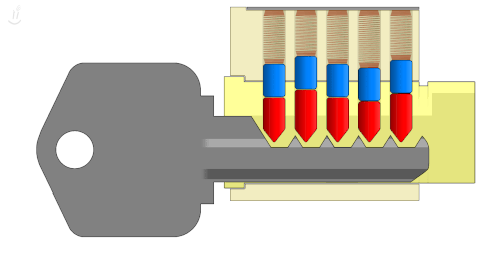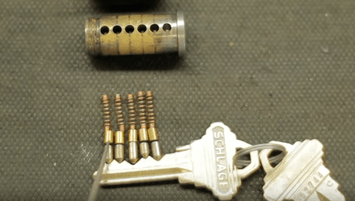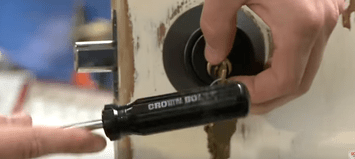By: Tere Scott on June 3rd, 2018 at 03:25 AM | Tampa, Florida
We'd like to think our locks are pick-proof to keep us safe from break ins, but the truth is that almost every affordable lock you buy from a hardware store, or locks that home builders include with the construction, is going to be easy to break into by a process called bumping. No, this doesn't mean someone clumsily knocks into the door handle, and the door suddenly opens. The process involves some amount of skill and a bit of luck.
Almost for as long as there have been locks, there has been a way to pick or force them open. Some of these techniques were developed with the intent of breaking in, while some were designed by lock manufacturers as part of the lock development process and never intended to be used for burglary purposes. Forcing open a lock like this was first discovered in this way, by a locksmith, when he discovered it was a way to cause the cylinder to easily slide out of the lock.
In brief, whoever wants to open your lock simply uses a key made by the same manufacturer as your lock, modifies it so that they are able to insert it into your door's lock and taps it quickly with blunt force, hence the name. It doesn't take a lot of know-how to get the job done and unlock your doors that you thought were secure.
Breaking open a lock in this way is actually quite easy to do, and almost everyone is vulnerable to having their locks opened in this manner.
So, how is it done?
When it comes to picking a lock, there are traditional pick gun style tools which most professional locksmiths have on hand, or you can use to drill to get the lock open. Alternatively, you can open a lock with not much effort and little or no practice through the process of bumping.
Not all locks are going to open as easily as others, but most are possible to unlock, including a secure Master Lock and even some high-end locks. The lock may actually be high end on the outside, but the cylinder inside is cheap. The manufacturer may be highly respected, and the lock design look impressive. Because of this, you assume it is a secure lock, but the inside is actually quite easy to open.
Because of this vulnerability, tricking the lock to open by force is made possible. All that is required is a specific key and a blunt object like a hammer or end of a screwdriver. The way it is done is that to break in, you put the key all the way in, pull it one notch out, and then hit the key head with a blunt object until it’s able to turn the lock. Too much pressure binds the tumblers, and it won't snap up. It takes a good even fast whack! A hammer or other blunt object is used to create the sudden force that breaks the lock open. Of course, there is some amount of skill involved in getting the feel for when to turn it slightly to the right and how far out to pull the key before hitting it. Some streamline the process by inserting a small rubber gasket onto the key to eliminate the second step of needing to pull the key back out slightly. Keep in mind that those who want to break in will want to do so as quickly and efficiently as possible, so any seconds they can shave off of this time is going to make their actions more swift. Adding a small rubber gasket around the key makes the process faster.
What makes locks vulnerable?
A pin and tumbler lock is made up of a few basic parts that include pins, a shear line, a cylinder, and a plug that is housed inside. To open the lock, you insert the proper key into the cylinder. In order to turn the key and unlock it, you must first have the right key with grooves that were cut for that specific lock to allow the pins to line up with the shear line so you can turn the key. The pins insider are of varying lengths. The secret to opening the lock is to get the pins to move to either side of the shear line for just one quick second to allow a quick, blunt force that lines up the driver pins above the shear line, leaving the key pins below and allowing the cylinder to turn.

The necessary key is basically any key made by the same lock maker or style as your lock that opens your door, but the grooves have been either machine or hand filed down. These keys are usually used on a standard pin tumbler lock. They are sometimes referred to as a 999, rapping, or a rap key.
All it takes is Googling, and you can often find an entire set for sale for less than $10. You can also take a file to file down the grooves on a key and create your own. If you use an O ring slid onto the key, you can even avoid the step of pulling the key back out slightly, and the O ring gasket allows you to manipulate the turning pressure which is the real secret behind success of opening the lock in this way.
You need a blank key specific to the brand of lock you want to open, but you cannot just walk into a store and buy a blank. However, you can get a copy of your key and file it down to the deepest groove with a round file. Keep the grooves aligned exactly to the original spacing. If they are cut on a machine, it will work easier, but a hand file will do. The industry standard is a 5-pin, or 5-cut positions. On commercial keys, there may be 6.
After learning how easy it is to break into a lock in this way, the thought that most locks may be useless in providing protection can be alarming. However, there are limitations in which kind of locks these special modified keys can open.
Is everyone at risk, or can I break-in proof my locks?
Almost every residential door lock is susceptible to break ins, but rest assured that there are some limitations. This technique of forcing open a lock will not work on some specific locking systems.
Are your locks secure?
Having a deadbolt installed is the quickest and most affordable way to stop break-in attempts in their tracks. Anti-lock devices that prevent the locking knob from turning is also an option as is installing security pins, keyless entry systems, or high-security locks.
There are real bump-proof locks. These locks run a bit more in cost, some upwards of $150, but are more secure. Schlage makes Primus high security locks and also make Everest which add an extra side milling as well as an extra tumbler that rides on that groove making the modified key unable to open the lock. The Everest has multiple grooves along the side milling. Medeco also has a high security lock that uses bi-axel teeth that are angled to twist inside the tumbler and allow the side bar to slide in. Trilogy programmable locks are even more secure for commercial purposes.
Protect your locks from forced entry break-in attempts by contacting one of our knowledgeable and local locksmiths who will be able to recommend the highest security locks for your individual needs.
Follow @tampalocks1















